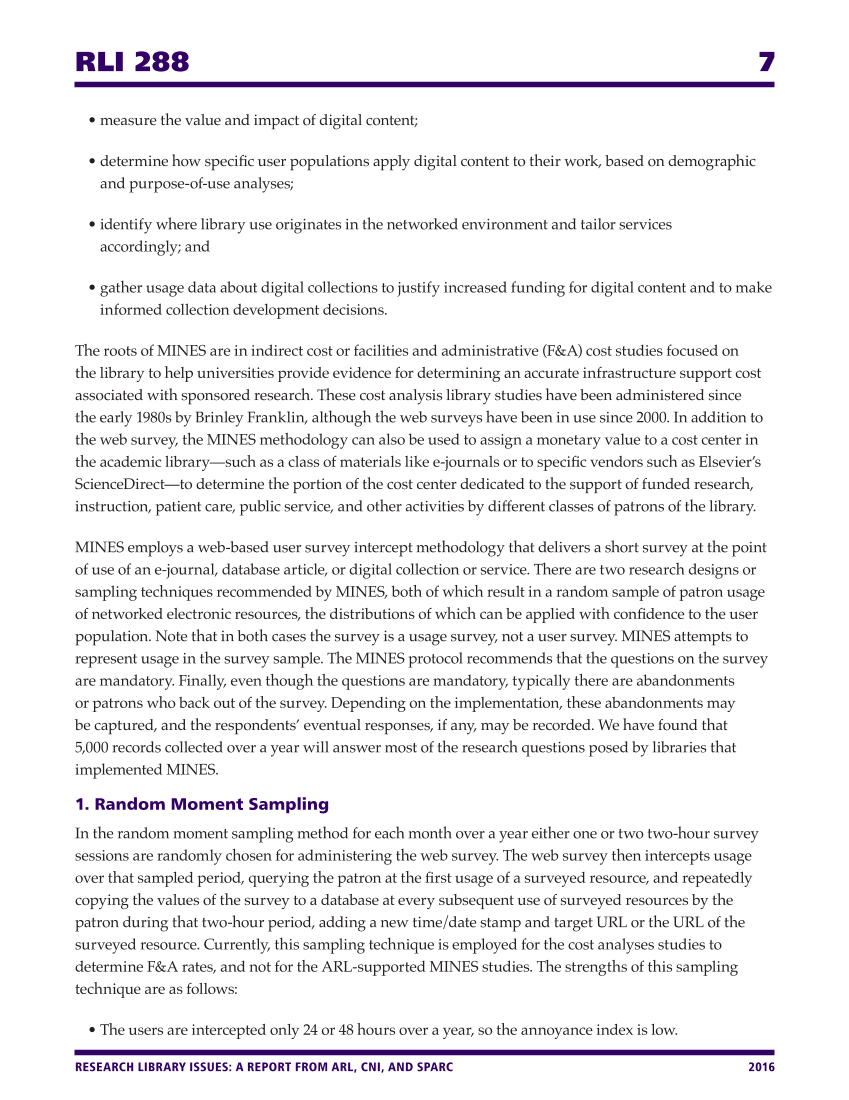RLI 288 7 RESEARCH LIBRARY ISSUES: A REPORT FROM ARL, CNI, AND SPARC 2016 • measure the value and impact of digital content • determine how specific user populations apply digital content to their work, based on demographic and purpose-of-use analyses • identify where library use originates in the networked environment and tailor services accordingly and • gather usage data about digital collections to justify increased funding for digital content and to make informed collection development decisions. The roots of MINES are in indirect cost or facilities and administrative (F&A) cost studies focused on the library to help universities provide evidence for determining an accurate infrastructure support cost associated with sponsored research. These cost analysis library studies have been administered since the early 1980s by Brinley Franklin, although the web surveys have been in use since 2000. In addition to the web survey, the MINES methodology can also be used to assign a monetary value to a cost center in the academic library—such as a class of materials like e-journals or to specific vendors such as Elsevier’s ScienceDirect—to determine the portion of the cost center dedicated to the support of funded research, instruction, patient care, public service, and other activities by different classes of patrons of the library. MINES employs a web-based user survey intercept methodology that delivers a short survey at the point of use of an e-journal, database article, or digital collection or service. There are two research designs or sampling techniques recommended by MINES, both of which result in a random sample of patron usage of networked electronic resources, the distributions of which can be applied with confidence to the user population. Note that in both cases the survey is a usage survey, not a user survey. MINES attempts to represent usage in the survey sample. The MINES protocol recommends that the questions on the survey are mandatory. Finally, even though the questions are mandatory, typically there are abandonments or patrons who back out of the survey. Depending on the implementation, these abandonments may be captured, and the respondents’ eventual responses, if any, may be recorded. We have found that 5,000 records collected over a year will answer most of the research questions posed by libraries that implemented MINES. 1. Random Moment Sampling In the random moment sampling method for each month over a year either one or two two-hour survey sessions are randomly chosen for administering the web survey. The web survey then intercepts usage over that sampled period, querying the patron at the first usage of a surveyed resource, and repeatedly copying the values of the survey to a database at every subsequent use of surveyed resources by the patron during that two-hour period, adding a new time/date stamp and target URL or the URL of the surveyed resource. Currently, this sampling technique is employed for the cost analyses studies to determine F&A rates, and not for the ARL-supported MINES studies. The strengths of this sampling technique are as follows: • The users are intercepted only 24 or 48 hours over a year, so the annoyance index is low.





































